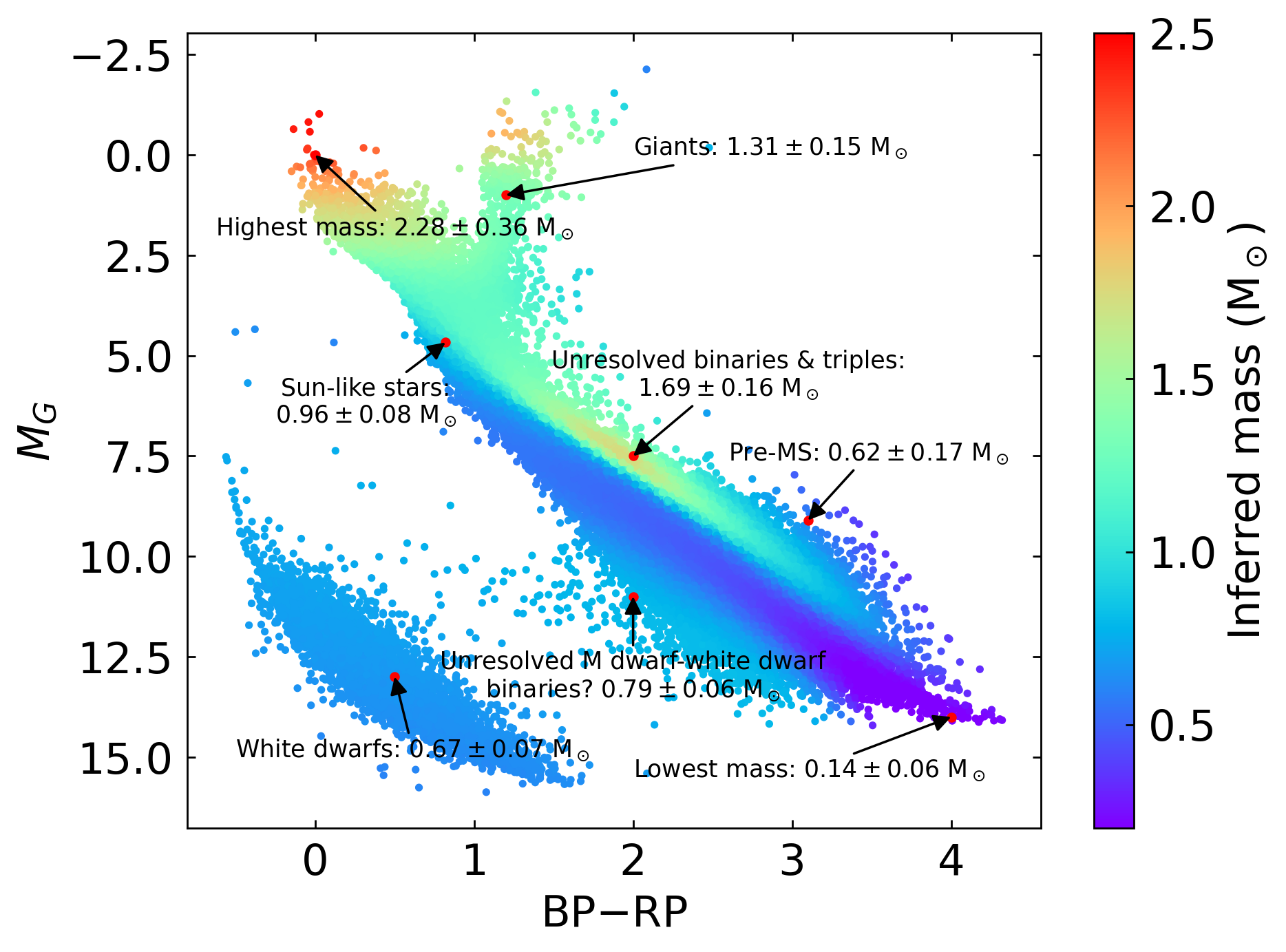IoW_20240625 - Gaia
Image of the Week
Dynamical masses across the Hertzsprung-Russell diagram
Figure 1. The dynamical masses measured using wide binary stars across the Hertzsprung-Russell Diagram, colour-coded on inferred solar masses. Several interesting masses are highlighted in the diagram. The inferred mean masses are highlighted with red dots. Credits: Hsiang-Chih Hwang, et al. 2024 MNRAS.
Have you ever wondered why some stars appear bluer while others are redder? Or why some stars shine brightly while others remain faint? These seemingly straightforward yet fundamental questions have intrigued humanity for centuries. Approximately a hundred years ago, astronomers Herzsprung and Russell unveiled a profound discovery, establishing that stars occupy specific regions in a colour-brightness space now known as the Hertzsprung-Russell diagram, often shortened to H-R diagram. Subsequent advances in stellar physics suggested that a star's mass largely determines its position on the H-R diagram, dictating its colour and brightness for a given stellar age.
The H-R diagram holds a paramount position in stellar physics and was featured prominently in one of the Gaia Collaboration's performance papers, titled "Gaia Data Release 2: Observational Hertzsprung-Russell diagrams". However, robust mass measurements in astronomy remained a challenge, hindering our ability to validate our understanding of stellar physics using observational data. Often methods rely on the derivation of stellar masses from stellar photometry, a method heavily influenced by the stellar models used. The mass derivations would be model-dependent. Other methods rely on for example double-lined eclipsing binaries, but due to their rareness, these measurements fell short of covering the entire H-R diagram. The definition of a weight scale that works for all stars in the H-R diagram in a robust way would provide a fundamental basis to work from, and this is what is aimed at by Hsiang-Chih Hwang and collaborators with their publication of the paper "Dynamical masses across the Hertzsprung-Russell diagram" in MNRAS earlier this year.
Now, with Gaia's latest data, a new avenue for mass measurement through the orbital motions of resolved wide binary stars opened up. Specifically, at a fixed binary separation, the more massive a binary star, the higher its orbital velocity, which is available in Gaia data thanks to Gaia's extraordinary astrometric precision. Hence, by employing statistical inference and machine learning techniques on a large sample of wide binary stars, such a universal weight scale is presented now: the measurement of stellar masses across the entire H-R diagram, as highlighted in the Figure above. It represents the first determination of dynamical masses across a wide parameter space, unifying disparate regions of the diagram. Dynamical mass measurements are provided for main-sequence stars, unresolved binaries and unresolved triples on the main sequence, as well as mean masses for giants and white dwarfs. Particularly intrigueing areas of the H-R diagram involve the pre-main-sequence stars and the other area potentially related to close compact object companions such as M dwarf - white dwarf combinations. The derived mass measurements rely solely on Newtonian dynamics and offer an independent validation of stellar evolution models as well as insights into the occurence rate of compact objects.
Inferred mean masses for the different stellar families like giants, Sun-like stars, white dwarfs, etc. are shown as well in the Figure above, highlighted with a red dot along with their value. These values have been compared to the mean masses obtained with different techniques and are in good agreement. The mass gradient in the white dwarfs as detected by gravitational redshifts is however not detected with this method. Future Gaia data releases may provide the critical data to further study this observed difference.
The unprecedented precision of Gaia's astrometry forms the foundation on which this research is built. With the extensive sample of wide binary stars that was published in Gaia's data release 3, in combination with the high-quality astrometric measurements, an overview of dynamical masses across the Hertzsprung-Russell Diagram is now available. This new weight scale represents a milestone for astronomers to confidently measure star masses in relation to their colour and brightness. It marks an important step to answer ancient questions about stars, and advancing our knowledge of stellar physics and the Milky Way.
Story written by Hsiang-Chih Hwang and Tineke Roegiers
Credits: ESA/Gaia/DPAC, Hsiang-Chih Hwang et al. MNRAS 2024.
[Published: 25/06/2024]
- Removed a total of (5) style text-align:center;
- Removed a total of (5) style text-align:justify;
Image of the Week Archive
- Removed a total of (1) border attribute.
- Removed a total of (1) cellpadding attribute.
- Removed a total of (1) cellspacing attribute.








































 Sign in
Sign in
 Science & Technology
Science & Technology
